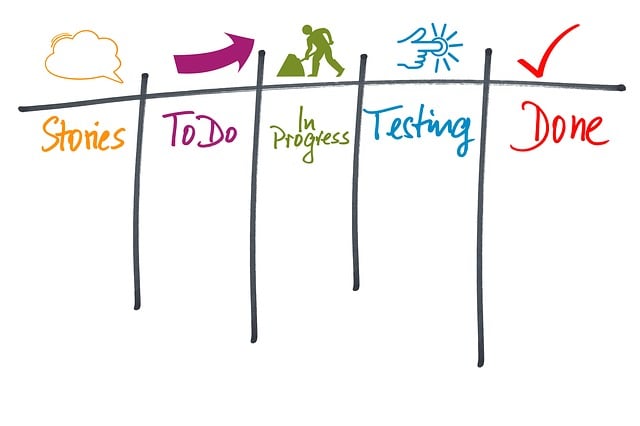Kanban is a Japanese term that means “visual signal” or “card.” It is a lean manufacturing method used to manage and improve work processes in manufacturing, software development, and other industries. The Kanban system helps teams to visualize the workflow, identify inefficiencies, and continuously improve the process. In this article, we will discuss how to maximize efficiency with Kanban.
Visualize your workflow
The first step in implementing Kanban is to visualize your workflow. Create a Kanban board that represents the process, from start to finish. This can be a physical board with sticky notes or an online tool like Trello or Asana. The board should include columns that represent the different stages of the process, such as “To Do,” “In Progress,” and “Done.”
Limit work in progress (WIP)
The second step in maximizing efficiency with Kanban is to limit work in progress. This means setting a limit on the number of tasks that can be in progress at any one time. The idea behind this is that by limiting the number of tasks in progress, you can reduce the time it takes to complete each task, reduce the amount of multitasking, and improve overall quality.
Manage flow
The third step in maximizing efficiency with Kanban is to manage flow. The goal is to create a smooth flow of work through the system, from start to finish. This requires monitoring the progress of each task and identifying any bottlenecks or areas where work is getting stuck. Once identified, you can take steps to remove the bottleneck and improve flow.
Make process policies explicit
The fourth step in maximizing efficiency with Kanban is to make process policies explicit. This means defining the rules, guidelines, and procedures that govern the process. By making these policies explicit, everyone on the team can understand how the process works and what is expected of them.
Implement feedback loops
The fifth step in maximizing efficiency with Kanban is to implement feedback loops. This means setting up mechanisms for collecting feedback from customers, stakeholders, and team members. The feedback can be used to identify areas for improvement and to make changes to the process.
Improve collaboratively and evolve experimentally
The final step in maximizing efficiency with Kanban is to improve collaboratively and evolve experimentally. This means creating a culture of continuous improvement, where everyone on the team is encouraged to identify areas for improvement and suggest changes to the process. By experimenting with small changes and measuring the impact, the team can gradually evolve the process to maximize efficiency.
In addition to these steps, there are a few best practices to keep in mind when using Kanban to maximize efficiency:
- Keep the board up-to-date: Make sure that the Kanban board is kept up-to-date with the latest information. This will ensure that everyone on the team has an accurate understanding of the current state of the process.
- Use metrics to measure progress: Use metrics such as cycle time, lead time, and throughput to measure the progress of the process. This will help to identify areas for improvement and measure the impact of any changes made to the process.
- Encourage collaboration: Encourage collaboration between team members to improve communication and ensure that everyone is working together towards the same goals.
- Emphasize continuous improvement: Emphasize the importance of continuous improvement and encourage everyone on the team to suggest changes to the process.
- Prioritize tasks: It’s important to prioritize tasks to ensure that the most important work is completed first. This can be achieved by using priority flags on the Kanban cards or by using swimlanes to group tasks by priority.
- Standardize work: Standardizing work involves creating a set of standard procedures for each task in the workflow. This ensures that everyone on the team is following the same process, reducing confusion and minimizing errors.
- Use automation: Automation can be used to reduce the amount of manual work required, freeing up team members to focus on higher-value tasks. For example, automation can be used to automatically move cards between columns based on predefined rules or to trigger notifications when certain conditions are met.
- Continuously monitor and adjust : Continuous monitoring and adjustment is key to ensuring that the Kanban process remains effective over time. Regularly review the workflow to identify areas for improvement and adjust the process accordingly.
- Encourage a culture of accountability: Encourage team members to take ownership of their work and be accountable for their tasks. This can be achieved by setting clear expectations, providing feedback, and recognizing achievements.
- Involve stakeholders: Involve stakeholders such as customers and other departments in the Kanban process to ensure that everyone is aligned and working towards the same goals. This can be achieved by sharing the Kanban board with stakeholders and soliciting feedback.
It’s important to remember that the success of Kanban in maximizing efficiency ultimately depends on the team’s ability to work together effectively. Foster a culture of collaboration, communication, and continuous improvement to ensure that the team is working towards the same goals and delivering high-quality work in a timely and efficient manner.
By following these steps and tips, teams can leverage Kanban to optimize their workflow, reduce waste, and increase efficiency. Whether working on software development projects, marketing campaigns, or any other type of project, Kanban can help teams achieve their goals more effectively and efficiently.
Also read: How Much Should I Charge To Clean A 2,000 sq ft House in 2023
Conclusion
Kanban is a powerful tool for maximizing efficiency in manufacturing, software development, and other industries. By visualizing the workflow, limiting work in progress, managing flow, making process policies explicit, implementing feedback loops, and improving collaboratively and evolving experimentally, teams can continuously improve the process and deliver high-quality work faster.

